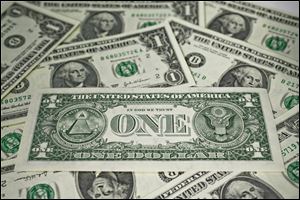
Coin fans say it’s time to cash out dollar bill
Paper money called costly for government
11/8/2011
A recent study says the U.S. government could save about $5.5 billion over 30 years if it phased out dollar bills, which last three years, in favor of dollar coins, which can circulate for three decades before they get worn out.
SCOTTSDALE, Ariz. — It is not typical for a politician to admit using a coin to decide critical issues, but there was Rep. David Schweikert (R., Ariz.), fishing out a dollar coin from his pocket the other day.
“See this?” he said, opening his palm and revealing the coin, heads up.
Mr. Schweikert was not flipping the gold-hued presidential dollar coin. He was using it as a prop to promote his idea of doing away with the dollar bill to save the government money.
A recent study by the Government Accountability Office said about $5.5 billion could be saved over 30 years if dollar bills, which last about three years on average, are replaced with dollar coins, which can circulate for three decades before they become worn out.
The projected savings have prompted some House Republicans, eager to pare government spending in these austere times, to champion a changeover.
Although doing away with the greenback has been debated for decades, many on both sides of the issue consider the odds, although long, to be better than ever.
As a result, coin and bill backers have begun a lively back and forth over the merits of such a remaking of the country’s currency.
They disagree on whether the coin would excessively weigh down consumers and complicate transactions for business owners. And they are far apart on whether the government would reap the savings that the accountability office predicts.
Mr. Schweikert’s point in showing the coin was that the dollar coin has evolved in the three decades since the introduction of the silver-hued Susan B. Anthony dollar, which confused Americans because of its similarity in size and color to the quarter.
“It fits the mantra of why we got elected — to save money,” said Mr. Schweikert, whose effort is backed by the coin lobby, an assemblage of mining interests, operators of coin-operated devices, and others who have formed a group called the Dollar Coin Alliance.
His proposed legislation to make this happen is called the COIN Act (Currency Optimization, Innovation, and National Savings Act).
The changeover faces opposition from those who do not want the dollar note to disappear. Calling themselves Americans for George, their members include the Mount Vernon Ladies’ Association as well as bingo operators, foresters, and Crane & Co., the Massachusetts paper maker that has provided the cotton stock used to make the country’s paper money for more than a century.
It is an emotional discussion. Paper backers imagine Americans wilting under the weight of dollar coins in their pockets and purses.
“The world won’t come to an end,” said Tom Ferguson, a dollar bill advocate who used to head the Bureau of Engraving and Printing. “But Americans will be carrying around a lot more coins.”
The costs of converting cash registers and vending machines are also raised, as well as the higher transportation costs associated with coins.
“It would be very cumbersome for the bartenders and the waiters who carry money around with them,” said Ken Cheuvront, a former Arizona state senator who now runs a restaurant and wine bar in Phoenix.
Their coin counterparts speak of the progressive people of Canada, Europe, and Australia, who use coins for their base currencies without any fuss and who look down at the paper American dollar as something akin to the horse and buggy.
Adopting the dollar coin, advocates say, means no one will ever have to suffer the indignity of having worn bills rejected by vending machines. And as for the weight issue, they say that five dollar coins weigh 1.5 ounces, which is less than a Snickers bar or a box of Altoids and considerably less than an iPhone 4.